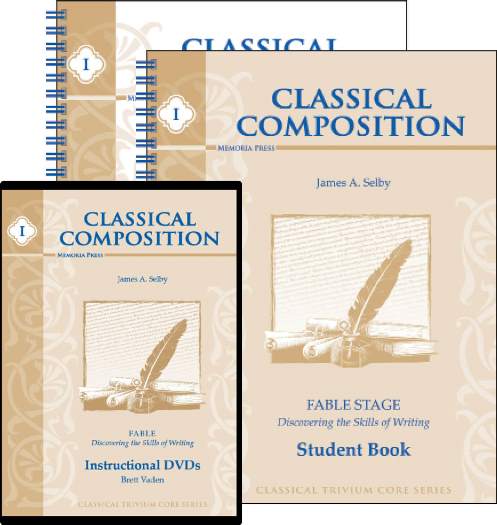Throughout out years of reviewing homeschooling materials
with the Crew, we have been fortunate to receive a number of excellent products
from Memoria Press. They are always so generous. In fact, during this
particular review, I had difficulty finding a product being offered that I don’t
already have in my library! For this review, I received Classical Composition I-Fable Set.
In my box of goodies, I received the Teacher Guide, Student
Book and the Instructional DVD's. It is intended to be used for grades 4-12.
There are a total of 20 lessons to work through.
As with any of the Memoria Press products the Teacher’s
Guide is excellent. It contains teaching
guidelines. The guidelines go through each aspect of the lessons carefully…even
providing extra hints and tips. A helpful rubric comes next. I love a good
rubric. Especially, if one isn’t quite sure how to “grade” a writing
project. The lessons plans, themselves,
are scripted and give plenty of examples and helps. The appendix at the back of
the book contains figures of description with examples.
The student book contains an introduction, a definition of
terms and the figures of description appendix. The lessons have the fable, accompanying
questions and space for writing.
One of my favorite parts are the instructional DVD’s. Brett
Vaden for the win! Thank you, Brett. Could you come to my house for a few other
subjects? There are 4 DVD’s that contain 5 lessons each. The lessons last about
30 minutes. I LOVE this kind of stuff. We are able to stop and start when
needed and rewind as often as we must.
So how does all this work?
Let me tell ya.
Each lesson contains a short fable. You can do this lesson
in one sitting or spread it out depending on your student’s abilities/attention
span or your schedule.
Mr. Brett reads the fable out loud. After the video lesson,
the student (aka Josiah) then reads the fable on his own. Then there are
vocabulary words to check out. All of the fables will contain three plot components….recognition,
reversal and suffering.
For example, Lesson 1 is the Ant and the Chrysalis. If you have never heard this particular fable
before, let me fill you in.
Mr. Ant is a busy guy. One day he comes across a Chrysalis
that is approaching his change. The Ant sees the Chrysalis move its tail and is
overcome with self-congratulations. He disdainfully tells the Chrysalis that he
pities him and then waxes on about his own superior ability of running and scurrying.
We all know what happens next. The Chrysalis is transformed into a beautiful
butterfly. The ant is overcome by the majesty of the Butterfly’s beautiful
wings. After a short speech, in which the Butterfly actually says “Behold in me”
and flies away, the ant is left to his own little pitiful self.
This, of course, is Beke’s version of the Fable.
So recognition is when the reader identifies with the story.
For example, in this case, Josiah knew exactly what an ant looks like when
searching for food. There is a little more to it, but you get the gist.
After identifying the plot components, the student works
through the Variations: Part 1 portion. He will first find synonyms for a
particular set of words. Then he will
turn the fable into an outline….which is awesome, by the way. The last portion
of Variations: Part 1 is to narrate or rewrite the fable using their outline.
Next is paraphrasing. I find this to be something Josiah
really struggles with. But it is a necessary part of writing (I use it all the
time in my own projects). In this
curriculum there are particular components that the students are expected to be
able to identify and work with.
So if we just left the lesson at that it would be great, but
there is more stuff to do!
Variations: Part 2 follows a similar procedure as the first
variation and then it is time to write the Final Draft.
Here are a few things I want to tell you.
Memoria Press is a Classical Education company. Their
products can be challenging in many respects. But they are also very thorough and
comprehensive. I find it is helpful not to be too ambitious…especially if you
are not used to a Classical Education model. What is really great about this
product, however, is that it does require the student to take his or her time
and think critically.
For us, these are not lessons that can be done in one
sitting. I also need to tell you that
Josiah is dyslexic. BUT…the shortness of the fables helped tremendously in that
regard. We also really took advantage of narration and were able to talk
through some of the concepts and trickier components.
I do know that this wouldn’t be one he could do by himself.
I also found that the rubric was helpful for him to look
through, as well. He liked to see what was expected of him.
Overall, this is a great product! Memoria Press doesn’t
disappoint. Be sure to check out all the Sample pages!
You can connect with Memoria Press via the following social
media outlets. Don’t forget to click on the banner below to read reviews for
other Memoria Press products!




No comments:
Post a Comment